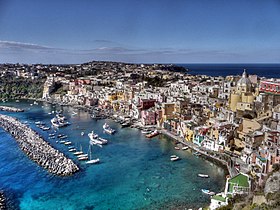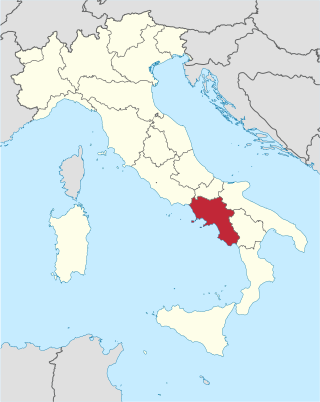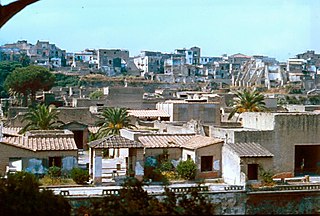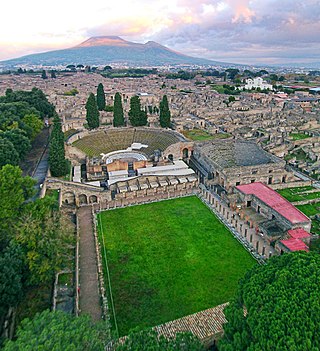
Corricella is a port on Procida in the Phlegraean Islands off the coast of Naples in southern Italy. It is known for its vibrantly colorful housing.

Corricella is a port on Procida in the Phlegraean Islands off the coast of Naples in southern Italy. It is known for its vibrantly colorful housing.

The Telegraph in 2017 listed Corricella as the 11th of Italy's 19 most-beautiful villages. [1] According to TheLocal.it, "...you can wander down the hill and into the colorful port of Corricella, where each house is painted in a different pastel shade." [2]
Tourist writer Nick Bruno mentions Corricella in 2013, describing "a fine spot for absorbing the picturesque Corricella harbor scene." [3] Corricella is "the most characteristic spot" on Procida according to the Rough Guides travel series. [4]

Corricella was the setting for the waterfront scenes in the 1995 Academy Award-winning movie Il Postino (The Postman) . [5]

Campania is an administrative region of Italy; most of it is in the south-western portion of the Italian peninsula, but it also includes the small Phlegraean Islands and the island of Capri. The capital of the Campania region is Naples. As of 2018, the region had a population of around 5,820,000 people, making it Italy's third most populous region, and, with an area of 13,590 km2 (5,247 sq mi), its most densely populated region. Based on its GDP, Campania is also the most economically productive region in southern Italy and the 7th most productive in the whole country. Naples' urban area, which is in Campania, is the eighth most populous in the European Union. The region is home to 10 of the 58 UNESCO sites in Italy, including Pompeii and Herculaneum, the Royal Palace of Caserta, the Amalfi Coast and the Historic Centre of Naples. In addition, Campania's Mount Vesuvius is part of the UNESCO World Network of Biosphere Reserves.

Mount Vesuvius is a somma-stratovolcano located on the Gulf of Naples in Campania, Italy, about 9 km (5.6 mi) east of Naples and a short distance from the shore. It is one of several volcanoes forming the Campanian volcanic arc. Vesuvius consists of a large cone partially encircled by the steep rim of a summit caldera, resulting from the collapse of an earlier, much higher structure.

Il Postino: The Postman is a 1994 comedy-drama film co-written by and starring Massimo Troisi and directed by English filmmaker Michael Radford. Based on the 1985 novel Ardiente paciencia by Antonio Skármeta, itself adapted from a 1983 film written and directed by Skármeta, the film tells a fictional story in which the real life Chilean poet Pablo Neruda forms a friendship with a simple Procida postman (Troisi) who learns to love poetry. The cast includes Troisi, Philippe Noiret, and Maria Grazia Cucinotta. The screenplay was adapted by Radford, Troisi, Anna Pavignano, Furio Scarpelli, and Giacomo Scarpelli.

The Villa of the Papyri was an ancient Roman villa in Herculaneum, in what is now Ercolano, southern Italy. It is named after its unique library of papyri scrolls, discovered in 1750. The Villa was considered to be one of the most luxurious houses in all of Herculaneum and in the Roman world. Its luxury is shown by its exquisite architecture and by the large number of outstanding works of art discovered, including frescoes, bronzes and marble sculpture which constitute the largest collection of Greek and Roman sculptures ever discovered in a single context.

The Gulf of Naples, also called the Bay of Naples, is a roughly 15-kilometer-wide (9.3 mi) gulf located along the south-western coast of Italy. It opens to the west into the Mediterranean Sea. It is bordered on the north by the cities of Naples and Pozzuoli, on the east by Mount Vesuvius, and on the south by the Sorrento Peninsula and the main town of the peninsula, Sorrento. The Peninsula separates the Gulf of Naples from the Gulf of Salerno, which includes the Amalfi Coast.

The Last Day of Pompeii is a large history painting by Karl Bryullov produced in 1830–1833 on the subject of the eruption of Mount Vesuvius in AD 79. It is notable for its positioning between Neoclassicism, the predominant style in Russia at the time, and Romanticism as increasingly practised in France. The painting was received to near universal acclaim and made Bryullov the first Russian painter to have an international reputation. In Russia it was seen as proving that Russian art was as good as art practised in the rest of Europe. It inspired Edward Bulwer-Lytton's world-famous novel The Last Days of Pompeii. Critics in France and Russia both noted, however, that the perfection of the classically modelled bodies seemed to be out of keeping with their desperate plight and the overall theme of the painting, which was a Romantic one of the sublime power of nature to destroy man's creations.

The National Archaeological Museum of Naples is an important Italian archaeological museum, particularly for ancient Roman remains. Its collection includes works from Greek, Roman and Renaissance times, and especially Roman artifacts from the nearby Pompeii, Stabiae and Herculaneum sites. From 1816 to 1861, it was known as Real Museo Borbonico.

Salina is one of the Aeolian Islands north of Sicily, Southern Italy. It is the second largest island in the archipelago.

Ercolano is a town and comune in the Metropolitan City of Naples, Campania of Southern Italy. It lies at the western foot of Mount Vesuvius, on the Bay of Naples, just southeast of the city of Naples. The medieval town of Resina was built on the volcanic material left by the eruption of Vesuvius that destroyed the ancient city of Herculaneum, from which the present name is derived. Ercolano is a resort and the starting point for excursions to the excavations of Herculaneum and for the ascent of Vesuvius by bus. The town also manufactures leather goods, buttons, glass, and Lacryma Christi wine.

The Villa Poppaea is an ancient luxurious Roman seaside villa located in Torre Annunziata between Naples and Sorrento, in Southern Italy. It is also called the Villa Oplontis or Oplontis Villa A. as it was situated in the ancient Roman town of Oplontis.

The House of the Tragic Poet is a Roman house in Pompeii, Italy dating to the 2nd century BCE. The house is famous for its elaborate mosaic floors and frescoes depicting scenes from Greek mythology.

The ancient Roman city of Pompeii has been frequently featured in literature and popular culture since its modern rediscovery. Pompeii was buried under 4 to 6 m of volcanic ash and pumice in the eruption of Mount Vesuvius in AD 79.

Pompeii was an ancient city located in what is now the comune of Pompei near Naples in the Campania region of Italy. Pompeii, along with Herculaneum and many villas in the surrounding area, was buried under 4 to 6 m of volcanic ash and pumice in the eruption of Mount Vesuvius in 79 AD.

Herculaneum was an ancient Roman town, located in the modern-day comune of Ercolano, Campania, Italy. Herculaneum was buried under volcanic ash and pumice in the Eruption of Mount Vesuvius in 79 AD.

Aragonese Castle is a castle built on a small tidal island east of Ischia, at the northern end of the Gulf of Naples, Italy. The castle stands on a volcanic rocky islet that connects to the larger island of Ischia by a causeway.

Of the many eruptions of Mount Vesuvius, a major stratovolcano in southern Italy, the best-known is its eruption in 79 AD, which was one of the deadliest in history.

The Ischia Film Festival (IFF) is an annual international film festival held in the Aragonese Castle on the island of Ischia, Italy in late June to early July. Founded in 2003 and as of 2023 still directed by Michelangelo Messina, the festival focuses on film locations. Feature films in competition are eligible for four awards, and there are separate awards for short films and other categories.
Santa Maria del Soccorso is a church located within the archaeological site of Villa Jovis, on the island of Capri, Italy. It is situated on the summit of the Lo Capo hill at the eastern extremity of the island. The chapel-like church, was constructed ca. 1610. Its fittings include a bronze statue of the Madonna, a 1979 gift of the Caprese painter Guido Odierna (1913-1991). In the late 19th century, hermit lived at the church, keeping a visitor's book and selling wine.

The Destruction of Pompeii and Herculaneum is a large 1822 painting by English artist John Martin of the eruption of Mount Vesuvius in 79 AD. It follows the pattern set by his previous successful painting, Belshazzar's Feast, which was another depiction of a dramatic scene from history delivered from an esoteric point of view. The work appeared to be lost from the Tate Gallery storerooms soon after it was damaged by the 1928 Thames flood. However, it was rediscovered in 1973 and subsequently restored in 2011.

The Vesuvius red zone is the area designated to be quickly evacuated within a few days in the case of an eruption of Mount Vesuvius. The authorities believe that they will have two weeks' warning of an imminent eruption; the questions that arise are whether the population can be evacuated in time, despite a reluctance to leave their homes; and if there be as much as two weeks' warning in reality.